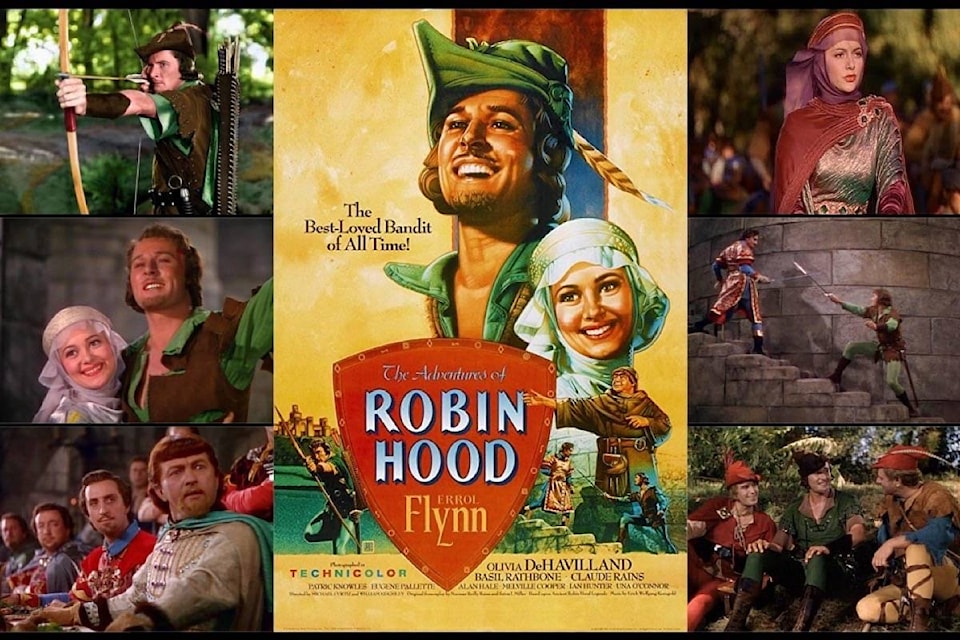Recently, while trolling through my Facebook feed, I stumbled upon an interesting comment, which was surprising, because “Facebook’ and “interesting comment” don’t always go together. It was about whether there was such a thing as the “perfect movie”, and consensus seemed to be that there wasn’t. However, one movie immediately leapt to mind as being as near as dammit perfect as it’s possible to get: 1938’s The Adventures of Robin Hood starring Errol Flynn.
If you’ve seen the film, you know precisely what I mean. If you haven’t, then get thee to it as quickly as humanly possible (also, where have you been for the past 82 years?). Those last words are crucial in appreciating what a wondrous film this is: it’s more than eight decades old, but is as fresh and sparkling as if it had been made yesterday.
That’s in no small part due to the decision by Warner Bros. to film it in colour, a technology that was still in its infancy in 1938. The three-strip Technicolor process in use at the time was cumbersome and expensive, requiring vast amounts of equipment and lights which made indoor scenes especially difficult for the actors (in The Wizard of Oz, made in 1939, Bert Lahr as the Cowardly Lion had a difficult time because the heat generated by the lights, combined with his heavy costume, caused him to nearly pass out more than once).
But it pays off gloriously in Robin Hood, which still shines like a lustrous jewel, from the greens of Nottingham Forest (filmed in California) and the blue of the sky to the deep golds and reds of the costumes. It also sets this version of the legend apart from more modern screen interpretations, where everything seems coloured from a palette that this is limited to “mud”. That might be more historically accurate (the 13th century isn’t known for its cleanliness and vivid fashion colours), but as Maxwell Scott says in The Man Who Shot Liberty Valance, when the legend becomes fact, print the legend.
Then there is Flynn’s Robin Hood, who is very much the bold and sympathetic hero. This also sets the film apart from many modern iterations, where Robin is a conflicted and/or tortured and/or troubled soul battling all manner of personal demons. No; the Flynn version was made at a time when Hollywood producers would have thought a “gritty reboot” meant dirty footwear. His Robin is unambiguously the person audiences are supposed to root for, just as Basil Rathbone’s Sir Guy of Gisbourne is the hiss-worthy villain par excellence, and their climactic swordfight is one of the very best in movie history, filmed in fluid, balletic, energetic long takes that make it clear both actors were doing their own stuntwork.
Rathbone is admirably supported in the dastardly stakes by Claude Rains as the oily, scheming Prince John and Melville Cooper as a smarmy Sheriff of Nottingham who is a yes-man of epic proportions. However, they and their forces are no match for Robin and his merry men, played by a who’s who of character actors who knew more about stealing a scene than most actors have forgotten. Then there’s a radiantly beautiful Olivia de Havilland, only 21 when she made the film, as Lady Marian, who evolves from an entitled noblewoman to a true believer in, and supporter of, Robin’s cause.
There’s barely time to mention Erich Wolfgang Korngold’s glorious score, which has been likened to a medieval light opera, and the sparkling script (is Flynn’s Robin the first action movie protagonist to utter witty quips in the face of almost certain death?), and the amazing set-pieces (the archery contest, Robin’s almost-hanging, the ambush in Sherwood Forest), and — well, see for yourself. There might be no such thing as the perfect movie, but if there’s a better contender for the crown, I’d love to hear about it.
editorial@accjournal.ca
Like us on Facebook and follow us on Twitter
